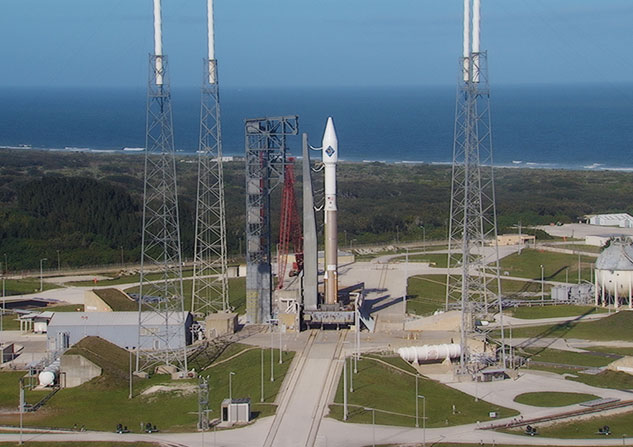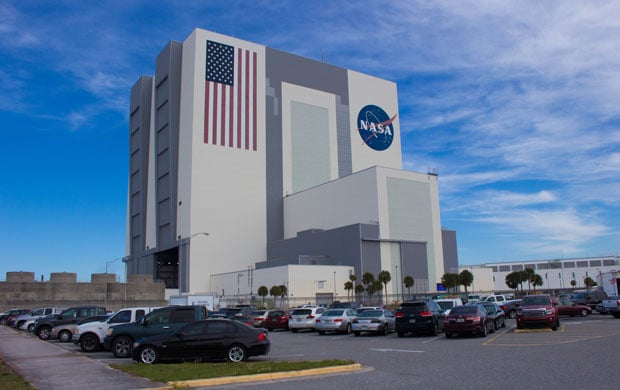Behind The Scenes Of NASA’s ISS Resupply Mission And The Future Of U.S. Manned Spaceflight
The Gecko Gripper
First, there’s the Gecko Gripper, which attempts to mimic the adhesion properties of gecko feet. Through the use of nanomaterials that are much thinner than the width of a human hair, Gecko Grippers can be repeatedly applied and removed from a surface, without losing its adhesive properties, via the use of van der Waals forces. And since the Gecko Grippers don’t leave residue behind like tape or glue, they could possibly be used in future space missions for robots that could “walk” outside the International Space Station (ISS) to perform repairs or general maintenance on modules. Gecko Grippers are also unaffected by temperature, pressure or radiation, which is quite enviable in space.
The admittedly small Gecko Grippers that we were shown today can hold up to 15 pounds (on a flat, smooth surface) before adhesion fails. Larger models, however, can hold up to 35 pounds. Since current generation Gecko Grippers cannot effectively clone every single aspect of gecko’s feet, it’s currently limited to testing on smooth surfaces — rough surfaces present a tougher challenge and result in a much lower weight threshold before adhesion failure occurs.
Strata-1 Experiment
Strata-1 will be used to test how asteroid regolith — loose dust, soil and rock — behave in a microgravity environment. The ISS represents a perfect testing ground, as its microgravity environment is similar to that of what you’d find on an asteroid. Four different types of materials will be sent up, each in four clear polycarbonate tubes, which will be monitored over the course of a year via a credit card-sized camera.
Saffire Experiment
Although small fires have previously been set in space — in a controlled environment of course — Saffire is a much larger test that will show how fires propagate in a weightless environment. Whereas previous first tests in space have been conducted on materials about the size of a postcard, Saffire will use a piece of SIBAL cloth that measures roughly three feet long and one foot wide.
“Saffire will be the biggest man-made fire ever in space,” said Gary Ruff, NASA Spacecraft Fire Safety Demonstration project manager.
Unlike the other scientific tests, Saffire testing won’t take place aboard the ISS. Instead, Saffire will stay within Cygnus and will be surrounded by trash discarded by the ISS crew to send back to Earth. Signals from the ground will be sent up to Saffire, after which an electrical charge will initiate the “burn” to get the experiment started. Cameras and sensors will monitor the fire, and the data will be used to help pave the way for future Saffire experiments and to ensure that future spacecraft are safer for occupants. Once testing is completed, the Saffire testing equipment will burn up during reentry along with the Cygnus cargo vehicle over the Pacific Ocean.
Equipment, Supplies And A Look At The "VAB"
Also onboard the Cygnus spacecraft is Meteor, which will be used to monitor the chemical composition of meteors entering Earth’s atmosphere, and the ISS will be receiving a second, brand new 3D printer. And if that wasn’t enough, Cygnus will also launch over two dozen microsatellites while docked to the ISS and while in orbit.
In addition to the briefings on the experiments going up, we were also able to take a tour inside the massive Vehicle Assembly Building (VAB) — one of the largest buildings in the world. It’s one thing to see the VAB in pictures, but seeing it in person is quite the experience. And actually going inside the VAB gives you an even better grasp on how stinkin’ huge it is.

Inside the VBA looking up at a massive crane (yellow) previously used to hoist the Space Shuttle
ULA Crew Access Arm
Our final stop on the trip was to see the United Launch Alliance (ULA) Crew Access Arm, which is currently mounted to a test stand about 45 minutes from Space Launch Complex 41 (SLC 41). The Crew Access Arm will sit atop the 200-foot tall Crew Access Tower. Astronauts will board (or exit in the case of an emergency) the CST-100 Starliner crew capsule (which sits atop a ULA Atlas V rocket) via the Crew Access Arm.
During the course of its normal operation, it takes just over two minutes for the arm to move from its stowed to open position so that crew members can enter the vehicle — after the astronauts are settled, the arm swings back into its stowed position. However, should an emergency occur that would require the astronauts to exit the vehicle, the Crew Access Arm can be swung back to the full open position in just 15 seconds with the help of a multi-ton counterweight and dampers to soften the effects of the rapid deployment.
We will of course have more coverage tonight, including on-site footage of the nighttime CRS-6 launch, which occurs at 11:05pm EST. Stay tuned!








